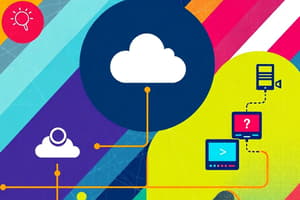Podcast
Questions and Answers
The Internet of Everything (loE) is an era where all computers, mobile phones, and intelligent terminals are connected through servers.
The Internet of Everything (loE) is an era where all computers, mobile phones, and intelligent terminals are connected through servers.
False (B)
The PC era is considered to be entirely a server-based network.
The PC era is considered to be entirely a server-based network.
False (B)
The mobile era features browser applications running on iOS and Android systems.
The mobile era features browser applications running on iOS and Android systems.
True (A)
Traditional IT architectures rely heavily on software for their reliability.
Traditional IT architectures rely heavily on software for their reliability.
A single node in a centralized IT architecture cannot increase the processing performance.
A single node in a centralized IT architecture cannot increase the processing performance.
The migration to cloud architecture transforms enterprise data centers from resource silos to resource pooling.
The migration to cloud architecture transforms enterprise data centers from resource silos to resource pooling.
Cloud computing is a model for enabling ubiquitous, on-demand network access to a shared pool of configurable computing resources.
Cloud computing is a model for enabling ubiquitous, on-demand network access to a shared pool of configurable computing resources.
Cloud computing is often referred to as "the delivery of on-demand, measured computing services over the Internet."
Cloud computing is often referred to as "the delivery of on-demand, measured computing services over the Internet."
Cloud computing allows enterprises to provide better products to attract more users by making their lives more inconvenient
Cloud computing allows enterprises to provide better products to attract more users by making their lives more inconvenient
HUAWEI CLOUD Meeting allows interactive video and voice communications between people in two or more locations.
HUAWEI CLOUD Meeting allows interactive video and voice communications between people in two or more locations.
The video conferencing market in China is expected to grow at an average annual rate of less than 20%.
The video conferencing market in China is expected to grow at an average annual rate of less than 20%.
E-Gov Cloud Online Services enables access to comprehensive public services through the Internet.
E-Gov Cloud Online Services enables access to comprehensive public services through the Internet.
E-Gov Cloud services utilize compute, storage, network, security, and application resources in existing equipment rooms and leverage cloud computing to offer high reliability, availability, and elasticity.
E-Gov Cloud services utilize compute, storage, network, security, and application resources in existing equipment rooms and leverage cloud computing to offer high reliability, availability, and elasticity.
Online services are not considered to be a typical application of e-Gov.
Online services are not considered to be a typical application of e-Gov.
Intelligent Process Automation (IPA) robots are provided to guide users in E-Gov Cloud services.
Intelligent Process Automation (IPA) robots are provided to guide users in E-Gov Cloud services.
RPA technology handles all work items through the workbench, effectively collaborating with functional agencies in E-Gov Cloud services.
RPA technology handles all work items through the workbench, effectively collaborating with functional agencies in E-Gov Cloud services.
Public cloud is a type of cloud computing service that is developing considerably in China.
Public cloud is a type of cloud computing service that is developing considerably in China.
The main cloud vendors in China include China Mobile, China Unicom, China Telecom, local government cloud computing platforms, and public cloud platforms built by Internet giants.
The main cloud vendors in China include China Mobile, China Unicom, China Telecom, local government cloud computing platforms, and public cloud platforms built by Internet giants.
Enterprises with foreign technical backgrounds or introducing foreign cloud computing technologies are not considered to be public cloud vendors in China.
Enterprises with foreign technical backgrounds or introducing foreign cloud computing technologies are not considered to be public cloud vendors in China.
In a private cloud, all data is kept within the organization's data center to ensure maximum data protection.
In a private cloud, all data is kept within the organization's data center to ensure maximum data protection.
A public cloud service provider owns and operates the cloud infrastructure and provides cloud services to the public.
A public cloud service provider owns and operates the cloud infrastructure and provides cloud services to the public.
A hybrid cloud combines a public and private cloud, but they remain distinct entities.
A hybrid cloud combines a public and private cloud, but they remain distinct entities.
Infrastructure as a Service (IaaS) provides infrastructure, but users must maintain related resources.
Infrastructure as a Service (IaaS) provides infrastructure, but users must maintain related resources.
Platform as a Service (PaaS) provides infrastructure and the application deployment environment, but users are responsible for maintaining them.
Platform as a Service (PaaS) provides infrastructure and the application deployment environment, but users are responsible for maintaining them.
Software as a Service (SaaS) provides all resources, services, and maintenance, and users are only responsible for using applications.
Software as a Service (SaaS) provides all resources, services, and maintenance, and users are only responsible for using applications.
Cloud computing is a service-oriented mode that provides IT devices as services on demand.
Cloud computing is a service-oriented mode that provides IT devices as services on demand.
Cloud computing dynamically allocates resources to applications in software, which can optimize resource usage, and dynamically allocates the resources to applications in software.
Cloud computing dynamically allocates resources to applications in software, which can optimize resource usage, and dynamically allocates the resources to applications in software.
Cloud computing supports auto-scaling, which optimizes work efficiency by building high-specification cloud data centers and introducing automatic scheduling technology.
Cloud computing supports auto-scaling, which optimizes work efficiency by building high-specification cloud data centers and introducing automatic scheduling technology.
On-demand self-service is a benefit of cloud computing, which allows customers to deploy processing services based on actual requirements on the server running time, network, and storage.
On-demand self-service is a benefit of cloud computing, which allows customers to deploy processing services based on actual requirements on the server running time, network, and storage.
Broad network access is a benefit of cloud computing, where various capabilities can be obtained over the Internet, and the Internet can be accessed in standard mode from various clients.
Broad network access is a benefit of cloud computing, where various capabilities can be obtained over the Internet, and the Internet can be accessed in standard mode from various clients.
Resource pooling is a benefit of cloud computing, where computing resources are centralized so that customers can rent services.
Resource pooling is a benefit of cloud computing, where computing resources are centralized so that customers can rent services.
Quick deployment and auto-scaling is a benefit of cloud computing, where cloud computing can rapidly and elastically provide computing capabilities.
Quick deployment and auto-scaling is a benefit of cloud computing, where cloud computing can rapidly and elastically provide computing capabilities.
Metered services are a benefit of cloud computing, where cloud services are billed based on the actual resource usage, such as the CPU, memory, storage capacity, and bandwidth consumption of cloud servers.
Metered services are a benefit of cloud computing, where cloud services are billed based on the actual resource usage, such as the CPU, memory, storage capacity, and bandwidth consumption of cloud servers.
Massive scale is a characteristic of cloud computing, which means that IT resource supply is centralized.
Massive scale is a characteristic of cloud computing, which means that IT resource supply is centralized.
Homogeneity is a characteristic of cloud computing, which is similar to standardization.
Homogeneity is a characteristic of cloud computing, which is similar to standardization.
Virtualization is a characteristic of cloud computing that has two meanings: accurate computing units and the separation of software and hardware.
Virtualization is a characteristic of cloud computing that has two meanings: accurate computing units and the separation of software and hardware.
Elastic computing is a characteristic of cloud computing, which means that IT resources can be elastically provided.
Elastic computing is a characteristic of cloud computing, which means that IT resources can be elastically provided.
Low-cost software is a characteristic of cloud computing, which is provided to meet market competition and requirements, and makes it easy to use. Therefore, low-cost software is required to earn money at small profits but quick turnover.
Low-cost software is a characteristic of cloud computing, which is provided to meet market competition and requirements, and makes it easy to use. Therefore, low-cost software is required to earn money at small profits but quick turnover.
Geographic distribution is a characteristic of cloud computing, which is provided anytime and anywhere. Therefore, large public cloud service providers have dozens or even hundreds of data centers to provide cloud computing services to global customers.
Geographic distribution is a characteristic of cloud computing, which is provided anytime and anywhere. Therefore, large public cloud service providers have dozens or even hundreds of data centers to provide cloud computing services to global customers.
Service orientation is a characteristic of cloud computing, which means that the overall design is service-oriented.
Service orientation is a characteristic of cloud computing, which means that the overall design is service-oriented.
Advanced security technology is a characteristic of cloud computing, where advanced security technologies must be adopted to protect cloud computing.
Advanced security technology is a characteristic of cloud computing, where advanced security technologies must be adopted to protect cloud computing.
Flashcards
Cloud Computing
Cloud Computing
A model that enables on-demand access to configurable computing resources over a network. It allows users to access shared resources and services with minimal management effort.
Internet of Everything (IoE)
Internet of Everything (IoE)
The era where devices and systems are interconnected via the internet. All computers, phones, and terminals are connected, enabling an internet of everything.
Traditional IT Architecture
Traditional IT Architecture
The conventional IT architecture consists of hardware and software, including infrastructure, data centers, servers, network hardware, desktop computers, and enterprise application software solutions. They require more power, physical space, and capital, and are typically installed locally for enterprises.
Virtualization
Virtualization
Signup and view all the flashcards
Cloud Transformation
Cloud Transformation
Signup and view all the flashcards
Characteristics of Cloud Computing
Characteristics of Cloud Computing
Signup and view all the flashcards
Private Cloud
Private Cloud
Signup and view all the flashcards
Public Cloud
Public Cloud
Signup and view all the flashcards
Hybrid Cloud
Hybrid Cloud
Signup and view all the flashcards
Infrastructure as a Service (IaaS)
Infrastructure as a Service (IaaS)
Signup and view all the flashcards
Platform as a Service (PaaS)
Platform as a Service (PaaS)
Signup and view all the flashcards
Software as a Service (SaaS)
Software as a Service (SaaS)
Signup and view all the flashcards
Elastic Computing
Elastic Computing
Signup and view all the flashcards
Metered Services
Metered Services
Signup and view all the flashcards
On-Demand Self-Service
On-Demand Self-Service
Signup and view all the flashcards
Broad Network Access
Broad Network Access
Signup and view all the flashcards
Resource Pooling
Resource Pooling
Signup and view all the flashcards
Benefits of Cloud Computing: Improved Resource Usage
Benefits of Cloud Computing: Improved Resource Usage
Signup and view all the flashcards
Benefits of Cloud Computing: Centralized Data Storage
Benefits of Cloud Computing: Centralized Data Storage
Signup and view all the flashcards
Benefits of Cloud Computing: Cost Optimization
Benefits of Cloud Computing: Cost Optimization
Signup and view all the flashcards
Cloud Computing Characteristics: Massive Scale
Cloud Computing Characteristics: Massive Scale
Signup and view all the flashcards
Cloud Computing Characteristics: Homogeneity
Cloud Computing Characteristics: Homogeneity
Signup and view all the flashcards
Cloud Computing Characteristics: Virtualization
Cloud Computing Characteristics: Virtualization
Signup and view all the flashcards
Cloud Computing Characteristics: Low-cost Software
Cloud Computing Characteristics: Low-cost Software
Signup and view all the flashcards
Cloud Computing Characteristics: Geographic Distribution
Cloud Computing Characteristics: Geographic Distribution
Signup and view all the flashcards
Cloud Computing Characteristics: Service Orientation
Cloud Computing Characteristics: Service Orientation
Signup and view all the flashcards
Cloud Computing Characteristics: Advanced Security
Cloud Computing Characteristics: Advanced Security
Signup and view all the flashcards
Study Notes
Cloud Computing Basics
- Enterprises demand more compute, storage, and networking resources, leading to cloud computing's emergence.
Background of Cloud Computing
- Mobile internet prevalence and data explosion create challenges for traditional ICT.
- The PC era involved networked computers, with connections through servers.
- The mobile era uses mobile phones to access the internet, showcasing connectivity via 5G, moving toward an Internet of Everything (loE).
- The loE era highlights an ecosystem competition.
- PC era relied on Windows, Intel chips, and x86 architecture with internet browsers.
- Mobile era uses iOS and Android systems on ARM architecture.
- Future industry leaders will command core chip and operating system technologies.
Challenges Faced by Conventional IT Architecture
- Traditional IT architecture faces difficulties with rapid development, including longer procurement periods, restricted scalability, and dependence on software for device reliability.
- Heterogeneous devices and vendors pose management problems.
- Limited individual device performance and high total costs.
Enterprises Are Migrating to the Cloud Architecture
- Visual comparison showing the transition from conventional to virtualized and cloud architectures with application layers, operating systems, and virtualization layers.
Definition of Cloud Computing
- Cloud computing allows ubiquitous, convenient, on-demand network access to shared computing resources with rapid provisioning and minimal management.
- "Cloud" is a metaphor for the internet and infrastructure.
- Computing services encompass functionality, resources, and storage.
- Cloud computing delivers on-demand computing services via the internet.
Cloud Computing Is Around Us
- Cloud services, such as music, albums, video streaming, and document applications, illustrate practical examples of cloud computing use.
- Cloud computing allows for better products to enhance user-interactions.
Cloud Services and Applications Around Us (Enterprises)
- Examples demonstrate cloud technologies in communication, especially video conferencing, showing public service applicability.
E-Gov Cloud Online Services
- These cloud-based online services simplify application processes, use existing equipment, and grant high reliability/availability/elasticity to governmental bodies.
Public Cloud Deployment Models
- Private cloud infrastructures are dedicated to single organizations with data protection measures.
- Public cloud services are offered by providers for general-purpose use.
Cloud Computing Models
- Cloud service models include IaaS, PaaS, and SaaS, differing in how services are provided.
Service Model Overview
- A diagram illustrates different cloud service models' layers(IaaS, PaaS, and SaaS) showing underlying hardware, operating system, middleware, and various applications.
Benefits of Cloud Computing
- Consolidation of hardware resources facilitates efficient resource utilization.
- Auto-scaling and high-spec cloud data centers improve performance and cost-efficiency, focusing on data storage and usage.
- On-demand services, broad network access, resource pooling, quick deployment, efficient computing, and security are cloud benefits.
Eight Common Characteristics of Cloud Computing
- Massive scale and standardization (homogeneity) are key attributes in contrast to traditional IT setups.
- Virtualization divides resources and improves utilization.
- Elastic computing allows for flexible resource allocation based on requirements.
- Low-cost software simplifies IT management and usage.
- Geographic distribution across datacenters increases service availability and performance.
- Service orientation prioritizes the delivery of services.
- Advanced security features ensure cloud protection against various threats.
Studying That Suits You
Use AI to generate personalized quizzes and flashcards to suit your learning preferences.




